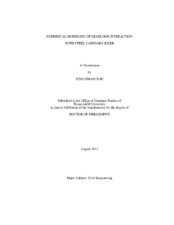| dc.description.abstract | Realistic predictions of service life of steel catenary risers (SCR) require an accurate characterization of seafloor stiffness in the zone where the riser contacts the seafloor, the so- called touchdown area (TDA). This paper describes the key features of a seafloor-riser interaction model based on the previous experimental model tests. The seafloor is represented in terms of non-linear load-deflection (P-y) relationships, which are also able to account for soil stiffness degradation due to vertical cyclic loading. The P-y approach has some limitations, but simulations show good agreement with experimental data. Hence, stiffness degradation and rate effects during penetration and uplift motion (suction force increase) of the riser are well captured through comparison with previous experimental tests carried out at the Centre for Offshore Foundation Systems (COFS) and Norwegian Geotechnical Institute (NGI).
The analytical framework considers the riser-seafloor interaction problem in terms of a pipe resting on a bed of springs, and requires the iterative solution of a fourth-order ordinary differential equation. A series of simulations is used to illustrate the capabilities of the model. Due to the non-linear soil springs with stiffness degradation it is possible to simulate the trench formation process and estimate deflections and moments along the riser length. The seabed model is used to perform parametric studies to assess the effects of stiffness, soil strength, amplitude of pipe displacements, and riser tension on pipe deflections and bending stresses. The input parameters include the material properties (usually pipe and soil), model parameters, and loading conditions such as the amplitude of imposed dis- placements, tension, and moment. Primary outputs from this model include the deflected shape of the riser pipe and bending moments along riser length. The code also provides the location of maximum trench depth and the position where the maximum bending moment occurs and any point where user is interested in. | en |


